by Winding Pathways | Feb 11, 2021 | (Sub)Urban Homesteading, Garden/Yard, Garden/Yard
Winter Readiness
Recently Rich donned a heavy jacket, gloves, and hat then ventured through swirling snow to the mailbox. He returned with seed catalogs. Seems early but there are two good reasons why we like to receive them in the depth of winter.

Seed catalogs make great winter reading.
First, they make fun reading as we sit in the cheery glow of the woodstove. It’s pleasant to see photos of colorful vegetables. Makes us long for spring.
Second, they remind us it’s time to buy our seeds. Gardening was amazingly popular last year as Coronavirus confined millions of people to their homes and potential food shortages were a concern. So many people bought seeds that they were hard to find. The lesson: Buy early.
We manage our small garden intensively and mix composted chicken manure into the soil. It makes vegetables seemingly explode in growth.
Here’s how we buy seeds:
Mail Order: Our favorite mail-order seed source is Seed Savers Exchange (seedsavers.org) in Decorah, Iowa. They specialize in organic, non-hybrid, non-GMO seeds. In other words, they sell classic vegetable varieties. We eat many winter squash, and Seed Savers sells a wide diversity of varieties. Our favorite is Silver Bell. It’s full of flavor, keeps all winter, and is just the right size for two people. We have ordered seeds from large format catalogs that come to our mailbox unrequested. They’ve been good seeds, but they tend to have fewer varieties of winter squash and some other vegetables. Most also sell flower seeds and fruit trees.
Over the Counter: Right after January 1st, home and garden stores put out their garden seeds. We often buy a dozen or so of the small envelopes of seeds.
Generally, they sell seeds packed by two types of companies. One is name brand seeds. The other is packets sold by companies with names we don’t always recognize. They are much less expensive than name brands. We usually buy some of each type and have had good success with the less expensive ones.
A Planting Tip
Lettuce, carrots, parsnips, radish, and many other seeds are tiny. It’s easy to plant them too close together. That results in tedious thinning in a month or two. We take the time to plant the seeds further apart to reduce the thinning chore. This also stretches the seeds in the envelope to produce more food. Often, we replant early vegetables and get a second, late-season crop.
-

-
Use chicken manure to enrich the soil.
-
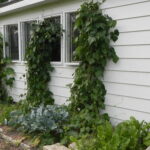
-
Save space and cool the cabin.
-
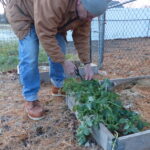
-
Intensive gardening maximizes space
Baby Chicks May Also Be in Short Supply
Last year hatcheries had trouble meeting the demand for baby chicks. Some customers were disappointed that they weren’t able to buy the breeds they wanted. We place our order at Hoover’s Hatcher (hoovershatchery.com) in the winter so we get the chicks we want at the best time for us.
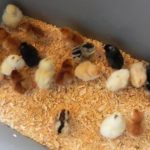
Chicks need to be warm until their insulating feather grow.
Seeds or baby chicks……order early.
by Winding Pathways | Dec 31, 2020 | (Sub)Urban Homesteading, Chickens, Garden/Yard
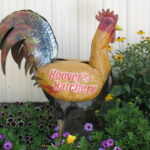
A booming business in rural Iowa.
Our relationship with Hoover’s Hatchery started years ago and launched a long and mutually beneficial relationship that keeps growing.
Thanks to quality products and innovative management, the Hatchery, located in tiny, Rudd, Iowa, is thriving today and offers increasing services to its primary market – small flock owners. Raising tiny chicken flocks has become a popular backyard activity that combines fresh eggs with a fun learning experience.
Questions? Turn to Hoover’s Hatchery
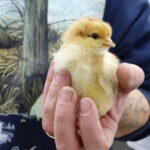
Hoover’s chicks are fed the best ingredients.
Many newcomers have limited or no experience keeping chickens. Hoover’s is there to help. Want a mixed flock of docile hens that lay brown, blue, green, or white eggs? Hoover’s sells the chicks. Need help learning how to care for them? Hoover’s website is filled with tips and the staff is just a phone call away. Want to learn more? Hoover’s will guide you. Hoover’s is accurate because as Tony Halsted, Director of Business Development, stated, “We rely on people who have kept chickens for years and know what they are doing.” They are successful because they innovate. Flock Journey is their latest innovation and expansion of partnering with businesses and small flock Ambassadors across the country. From backyard poultry experts in the northern climes to those in the South East to Homesteaders, Hoover’s works with experienced and creative people.
This winter Hoover’s is launching a new website called FlockJourney.com. It’s filled with chicken keeping tips. Marketing Manager, Kelsey Spotts, explains that Flockjourney is a “…one-stop-shop for backyard poultry.” Visitors can come to one site to get all the information they need.
Partners

Innovation has helped the business grow.
Hoover’s Hatchery partners with several proactive businesses to support healthy poultry. Strong Animals out of Marshall, MN, advocates natural solutions to poultry care. Nature Serve in DeMotte, IN, formulates poultry feed for optimal nutrition.
So, how does Winding Pathways fit? We write blogs for Hoover’s Websites and help with a monthly Facebook Live program. Take a peek at Hoover’s Hatchery website. And be sure to order your chicks early as the business is booming. And, Flockjourney is a one-stop site for information on Lifestyle, Breeds, and Poultry Care. The images are engaging, the blogs and videos both informative and entertaining, and topics range from warm treats to decorating the coop for holidays to chickens off the grid. There is always something brightening up the website, thus, encouraging your creativity as a poultry owner.
One of Several Hoover’s Hatchery Ambassadors
Why Winding Pathways? Well, we have plenty of experience. Rich has been keeping chickens since he was a child in New Jersey in the 1950s and Marion grew up in a family that gardened and raised chickens and pigs in New England. The Pattersons have kept chickens for most of their married life, tested many breeds in small flocks, and experimented to find easy and effective ways to keep chickens.
We blog occasionally about chickens on Winding Pathways and are proud to be part of the team with Hoover’s Hatchery to help encourage people everywhere to keep small flocks in ways that are fun, productive, and safe.
by Winding Pathways | Dec 24, 2020 | (Sub)Urban Homesteading, Chickens, Garden/Yard
Late December is special. There are lots to be thankful for and a good reason to celebrate. The solstice just passed, promising a daily addition of sunlight and signaling that spring is on the way. Then there’s a multitude of seasonal, cultural holidays and Holy Days. St. Lucia’s Day, Las Posadas, Yule Winter Solstice, Boxing Day, Kwanzaa, Christmas, and New Year’s Day.
People everywhere enjoy special year-end treats. For us, it’s stollen and pickled herring plus delicious cookies and, in some years, a tender roast beef dinner.
We remember our chickens and give them special year-end treats. They need it. Few things are as delicious to a hen as a juicy grasshopper or fresh grass shoot. By now those are just memories, and the poor birds have to make do with a diet of nutritious, but boring, commercial mash.
Jazz Up the Diet and Relieve Boredom
So, while keeping plenty of quality mash in the feeder, we jazz up their diet with these things:
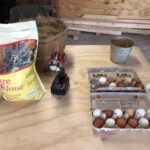
We vary the treats.
Mealworms: Our chickens might not like them as much as a June caterpillar but dried mealworms are a great winter substitute, so we sprinkle a couple of handfuls in the coop every day. These treats can be bought online or in farm and pet stores.
Sunflower seeds: Many people put sunflower seeds out for cardinals, chickadees, and other birds to enjoy on frosty days. Chickens also love them. We toss a handful of black oil sunflower seeds with the hulls on into the coop. They quickly disappear.
Squash seeds: We enjoy eating butternut and other winter squash during the cold days. Our chickens devour the seeds.
Scratch: Chickens love eating commercial scratch grain, a blend of corn, milo, wheat, and oats. A handful or two a day is plenty. It’s chicken candy but low in protein. Be careful when buying scratch. Some brands include a high percentage of milo, a grain that chickens don’t favor. It’s a round reddish colored seed. Try buying scratch with a low milo content.
Flock block: Each winter we buy a flock block. They’re made by several companies and are compressed scratch grain fortified with molasses and other treats. We simply put the heavy block on the coop floor. It takes the birds several weeks to eat it all and keeps them busy picking out tidbits. Farm and pet stores sell them. Some folks make their own!
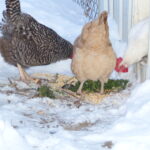
We toss a few treats outside the pophole door to entire the hens outside in winter.
On winter days, before enjoying our morning coffee and breakfast we open our coop’s pop hole door and scatter some chicken treats. We’re sure to say good morning and thanks to our hard-working hens.
-
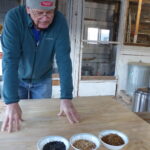
-
Rich shows three treats while a hen in the coop checks out what is happening.
-
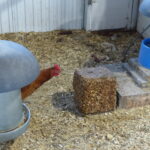
-
Hens check out new foods carefully.
-
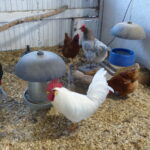
-
Chickens gather ’round the Flock Block.
-
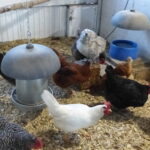
-
Satisfied that the Flock Block is something good, the hens and rooster begin to peck at it.
by Winding Pathways | Dec 17, 2020 | (Sub)Urban Homesteading, Garden/Yard, Geology/Weather, Nature, Trees
We won’t forget August 10, 2020. On that summer day, Cedar Rapids was hit with 140 miles an hour winds that tore off roofs, felled signs, and toppled at least 65% of the City’s trees. The damage was awesome.
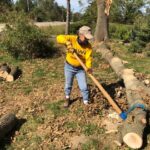 We lost 47 of our 53 big trees at Winding Pathways and spent the next two months cutting up a twisted jumble of trunks and branches. We bucked up what we could for firewood and made huge brush piles on the north end of our property for wildlife habitat. We used chain saws for cutting but muscle power to haul brush and wood.
We lost 47 of our 53 big trees at Winding Pathways and spent the next two months cutting up a twisted jumble of trunks and branches. We bucked up what we could for firewood and made huge brush piles on the north end of our property for wildlife habitat. We used chain saws for cutting but muscle power to haul brush and wood.
Nearly all woodland owners suffered similar damage, and most of them immediately began clearing away broken and downed trees. Some used heavy equipment to haul off debris, leaving bare soil in the woods, a perfect seedbed for weeds.
Resetting the Forest
The derecho reset Iowa’s woods. Prior to settlement most of the state was prairie with woodlands typically lining streams and rivers. Frequent wildfires raced through grasslands and never hesitated when they encountered woods. This created a savanna ecotype characterized by scattered fire-resistant big trees, mostly oaks, walnuts, and hickories, with a stunningly diverse array of wildflowers carpeting the ground.
Savanna was an “open” forest. It lacked a shrub understory, and because trees didn’t create a closed leafy canopy sunlight dappled the ground. Perhaps no forest is as beautiful or endangered as savanna.
Iowa’s settlers quickly suppressed fire. Gradually trees closed the canopy, keeping the ground in shade most of the day. Many savanna flowers need some sunlight and declined as a shrub layer, often of exotic invasive woody plants, thrived. Many woods that owners considered healthy were actually degraded by years of fire protection.
The derecho changed it within under an hour. Many trees fell to the ground, but others survived. Woodlands will now have sunlight reach the ground, stimulating both invasive species and long-suppressed native wildflowers.
Planning and Planting
The woods on the east side of our house created nearly a complete canopy, but suddenly they fell. After we cleared away the debris, we did these things:
- Planted a few white and bur oaks in the fall. We’ll plant a few more next spring. All are protected from deer browsing with a stout ring of wire mesh.
- Purchased a diverse mix of savanna wildflowers and a few kinds of grass from Pheasants Forever. Mid-November brought two inches of new snow, and we hustled out to broadcast the seeds on it. It’s called frost planting and works well.
- Discovered some tiny oaks, hackberries, and walnuts amid fallen trees. We marked them and know they’ll grow rapidly next year.
Recovery will be slow. Newly planted trees grow slowly their first few years and savanna and prairie seeds take a few years to establish. We don’t expect to see much change in 2021 but our “new” savanna will eventually be gorgeous and look much like it would have in the early 1800s.
Sources
We bought our prairie seed from www.pheasantsforever.org. Our fall-planted trees were ordered from the National Arbor Day Foundation www.arborday.org. Spring planting will be of trees we bought from Chief River Nursery www.chief rivernursery.com.
-
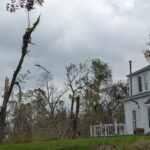
-
Trimming damaged trees.
-
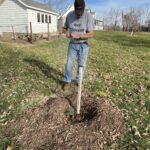
-
Arbor Day in November
-
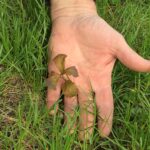
-
Discovering volunteer seedlings
-

-
Rich planting acorns gleaned from an undamaged timber patch
We’ll follow up our planting with occasional prescribed burns to retard invasive plants and invigorate natives.
by Winding Pathways | Dec 10, 2020 | (Sub)Urban Homesteading, Garden/Yard, Nature, Trees, Trees/Shrubs
Unusual Storm Clouds
The August storm looked like an ordinary thunderstorm approaching. Dark clouds gathered to the west as we sat on our porch. What happened minutes later was far from normal.
The roaring wind hit like a prize fighter’s fist, bending our small oaks and maples parallel to the ground. Before it struck, we had 53 mature, healthy trees on our two acres. Forty minutes later only six still stood somewhat unravaged. As we watched in dismay and horror our oaks, hackberries, cherries, pines, and Douglas Firs either uprooted or snapped off. At least our beloved black walnut still stood on the edge of the woods.
Then a massive gust later reported to be 140 miles an hour by the National Weather Service, stripped off the walnut’s branches. Soon, the wind calmed, allowing us to see tree carnage and home damage. It was shocking and started three months of clean up and reconstruction. We fixed the house but it’s not possible to replace century-old trees.
A Banner Day
In contrast to the August 10, 2020 derecho, Thursday, November 19 was a banner day.

Arbor Day in November
We had just received a box of trees from the National Arbor Day Foundation. After we tucked the oaks, maples, pines, and aspens into the ground we ringed them with a thick layer of wood chips and gave them a good drink of water. The chips came from massive fallen trees the City of Cedar Rapids ground up after the storm. Then we circled each tree with wire mesh to protect it from hungry deer. By afternoon we were tired but elated. We won’t live long enough to see our new trees as giants, but we gave them a good start.
Arbor Day Quality Trees
The baby trees looked great. It was our most recent purchase from the Arbor Day Foundation. Although inexpensive, they looked healthy and eager to grow. Even the bur and white oaks, which have robust and long taproots looked great.
In most places, Arbor Day is celebrated in late April. We’ll plant some more trees then, but we sat on our back deck on a warm November evening and enjoyed seeing our trees in their new homes. For us and our new trees, it was Arbor Day in November.
Lied Lodge and Arbor Day Foundation – Destination
We have visited the Arbor Day Foundation in Nebraska City, Nebraska, several times. It’s where Arbor Day was created. We’ve overnighted at Lied Lodge on the property and enjoyed walking trails on Arbor Day Farm.
So, if you need to buy trees check out arborday.org. Want a pleasant place to visit? The Farm and Lodge are less than an hour’s drive south of Omaha. Although we’ve been there several times, we look forward to returning.
by Winding Pathways | Dec 3, 2020 | (Sub)Urban Homesteading, Garden/Yard, Mammals, Nature, Pests
What a year this has been! Coronavirus altered the lives of nearly everyone. Many of us now work from home and spend the day staring at a computer screen and attending zoom meetings.
A delight of working from home is entertainment right outside the window. Sometimes we take our eyes off the screen, glance outside, and grin as we watch chipmunk antics.
No Need To Feed
We don’t really feed our chipmunks. They’re opportunists. When chickadees, nuthatches and other birds drop seeds from hanging feeders the chippies are right there filling their cheeks with sunflower seeds and dashing off to store them in their underground burrows.
Manly people detest these small, beautiful mammals and cite the damage they do to retaining walls and lawns. Our retaining wall is crafted of huge glacial boulders. Its many nooks and crannies are perfect for chipmunks but are so sturdy chipmunks can’t damage it. They give us cheer in a perplexing year.
Many species of chipmunks live in the United States but the one most common in suburban areas between the Atlantic and the Great Plains is the Eastern Chipmunk. Almost everyone can identify this animal that only tips the scale at two to three ounces. Counting its tail, a big one might stretch a foot long.
Where Do Chipmunks Live?
Chipmunks love what biologists call “structure”. A pile of firewood or old lumber, a brush pile, a rarely used shed, or a retention wall is structure that makes a dandy home for chipmunks. They typically create an extensive subterranean home under structures that is an extensive tunnel system with several entrances to the surface.
What’s In a Name?
Chipmunks were named by the Ojibwe Tribe with the words that mean, “one who descends trees headfirst.” Climb they can! Chipmunks scamper up and down trees and bushes and easily reach our bird feeding platform. They prefer sunflower seeds and stuff their cheek pouches until they seem ready to burst. Then they scoot off to store seeds down in their tunnels. We wonder how big that pile of seeds might be! Chippies also eat wild seeds, acorns, and even an occasional insect.
During the coldest weather chippies stay underground and sleep in a kind of torpor. They don’t hibernate and probably enjoy snacking on the sunflower seeds they cashed months before. Last winter one tunneled under the snow and emerged under our bird feeder for fresh seeds.
Overall Delight
We love watching our chipmunks chase one another up, down and around the feeder and retaining wall. Suburban chipmunks are fortunate. Snakes and raptors love snacking on them but people keep long, skinny reptiles out of yards and not many hawks venture near homes. Since chipmunks are day shift animals our barred owls don’t get a crack at them because they work the night shift.
So, in exchange for a safe place to eat, a scoop of seeds daily, and a cozy retaining wall to burrow in, our chipmunks give us a humorous and interesting break from working at home chores. CBS recently aired a short on a food editor who, during Coronavirus time has catered to a chipmunk outside her home. Sweet and tender show!
-
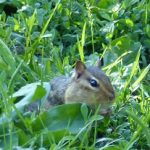
-
Foraging for seeds.
-
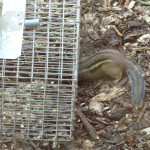
-
Having excavated, the chipmunk now enters the tunnel to get the corn.
-
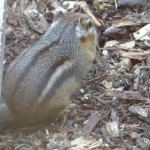
-
The chipmunk figured how to tunnel under the live trap, gather up the corn and emerged with pouches full.
-
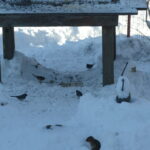
-
Chipmunks forage under the bird feeding platform.















 We lost 47 of our 53 big trees at Winding Pathways and spent the next two months cutting up a twisted jumble of trunks and branches. We bucked up what we could for firewood and made huge brush piles on the north end of our property for wildlife habitat. We used chain saws for cutting but muscle power to haul brush and wood.
We lost 47 of our 53 big trees at Winding Pathways and spent the next two months cutting up a twisted jumble of trunks and branches. We bucked up what we could for firewood and made huge brush piles on the north end of our property for wildlife habitat. We used chain saws for cutting but muscle power to haul brush and wood.






